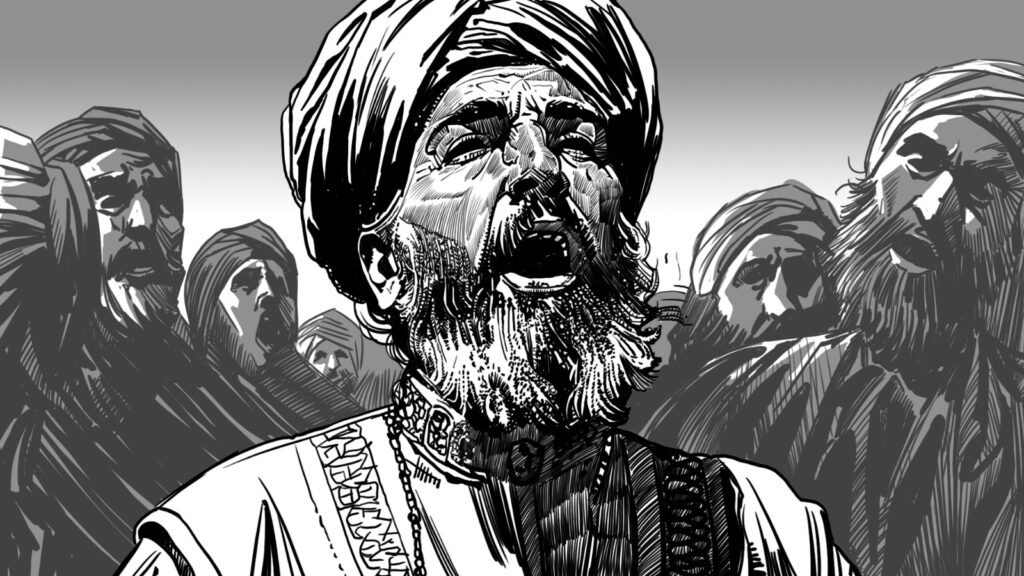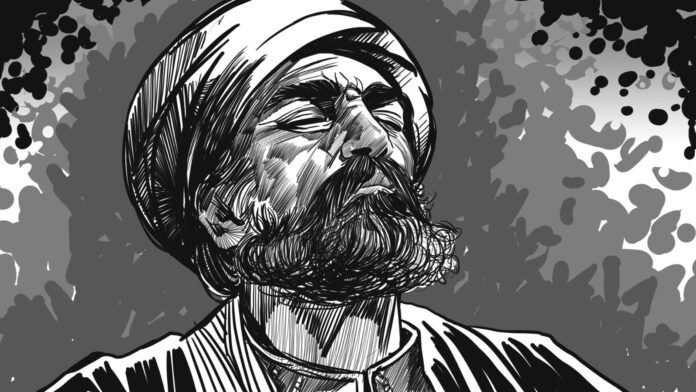Many opinions about Imam Ibn Taymiyyah have reached my ears—some praising him and others criticising him. Countless books about him have come into my hands, and I have come across just as many, if not more, television episodes, YouTube videos, and never-ending opinions. This drove me to read his books and fatwas myself to understand the storm of controversy surrounding this figure.
To begin with, we must agree that political, economic, and social conditions influence a person’s path and inclinations. Ibn Taymiyyah lived in an era shaken by turmoil. At the time, he witnessed the Islamic world being torn apart before his eyes and experienced the horrors of slaughter, massacre, and captivity without restraint.
Ibn Taymiyyah was born in 1263, five years after the fall of Baghdad at the hands of the Mongols. His life unfolded in a time dominated by chaos. History teaches us that we cannot ignore the distortions that politics can impose on individuals—it can either elevate a person’s status or tarnish their image and ideas.
He was Ahmad ibn Abdul-Halim ibn Abdul-Salam, known as Abu Al-Abbas. He was given the titles Taqi al-Din and Sheikh al-Islam. Due to his homeland, he was referred to as Al-Harrani, and because he studied in Damascus, he was also known as Al-Dimashqi. Additionally, he was called Al-Hanbali, as he followed the Hanbali school of thought, like his father, grandfather, and the people of his region. It is said that Taymiyyah was the name of his great-grandmother.
Ibn Taymiyyah mastered many sciences, memorising and transcribing numerous texts in his youth. He learned from many scholars and sheikhs and had an exceptional memorisation ability. He was known for his sharp intelligence, eloquent language, and dedication to both teaching and learning, as described by Al-Dhahabi in his biography of Ibn Taymiyyah.
Al-Dhahabi further states that Ibn Taymiyyah reached a level of knowledge and comprehension that enabled him to derive and interpret religious rulings, analyse Quranic verses, and evaluate narrators of hadith without relying on any specific imam or sheikh. This led him to contradict many prevailing opinions in his time and later generations.
Innovation, renewal, and deviating from the familiar can put a person in conflict with those deeply committed to other viewpoints. The clashes surrounding Ibn Taymiyyah’s opinions and fatwas began the moment they were issued and continue to this day.
What is astonishing is that despite his encyclopedic knowledge, he lacked communication skills. He was blunt and harsh, never conciliatory or diplomatic. He did not flatter or compromise and was aggressive toward his opponents, creating many enemies who sought to harm and bring him down.
As a result, Ibn Taymiyyah was imprisoned multiple times due to fatwas and opinions that I see as secondary matters—undoubtedly not significant enough to justify his imprisonment. This convinced me that there was something suspicious at play, a historical, political, and social context that had nothing to do with what he actually said.
Raed Al-Samhouri, in his book Ibn Taymiyyah: The Historical and the Recovered, discusses the political situation of that era and its impact on scholars.
Al-Samhouri mentions alliances between the Mongols and the Crusaders, as well as between Christians and Shiites against Sunni Muslims. He also highlights the corruption of the Mamluks, the internal conspiracies among them, and their use of deceit, betrayal, and assassination to gain power. The repeated rebellions by the governors of Damascus against the sultanate in Egypt made the city a constant concern, as it could secede at any moment. Additionally, Ismaili uprisings were demanding the return of the Fatimids to power.
Thus, Ibn Taymiyyah was influenced by his reality, era, and society. Naturally, tensions were high due to the political vacuum and the breakdown of public order. His life was filled with situations that sometimes displayed his bravery and, at other times, showed him as either a supporter or a silent observer of injustices.

During internal turmoil, Ibn Taymiyyah’s name emerged prominently in what became known as the As-Saf al-Nasrani Incident in 1294. Witnesses testified that As-Saf had insulted the Prophet, prompting Ibn Taymiyyah and another scholar to intervene and request his trial from the deputy of Damascus, Izz al-Din Aybak al-Hamawi. However, As-Saf sought protection from a nobleman, who enraged the public and pelted him with stones, leading to a significant disturbance described by Ibn Kathir as a severe commotion.
In response, the deputy of Damascus imprisoned Ibn Taymiyyah and the scholar accompanying him, punishing them with beatings for inciting unrest. Later, As-Saf was summoned to court, where he declared his conversion to Islam and proved that he had personal enmity with the witnesses, leading to the dismissal of the case and sparing his life. Consequently, Ibn Taymiyyah and his companion were released, ending the matter.
This incident highlighted Ibn Taymiyyah’s social and political influence in Damascus, where authorities viewed him as a symbolic threat to their power. It also marked a turning point in his life, prompting him to write his famous book, As-Sarim al-Maslul ‘ala Shatim ar-Rasul (The Drawn Sword Against the Blasphemer of the Prophet).
The book addressed four main points: first, that anyone who insults the Prophet must be executed, whether Muslim or non-Muslim; second, that even if the offender is a dhimmi (a non-Muslim under Islamic rule), they must still be executed without pardon or ransom; third, the ruling on one who repents after insulting the Prophet; and fourth, the distinction between blasphemy and disbelief.
Ibn Kathir also recorded another ordeal Ibn Taymiyyah faced in 1300 due to his Fatwa al-Hamawiyyah, which was directed to the people of Hama regarding the interpretation of God’s attributes as mentioned in the Qur’an and Hadith, such as the verse:
“The Most Merciful [God] has ascended over the Throne” (Qur’an 20:5)
and the Hadith:
“The hearts of the children of Adam are between two fingers of the Most Merciful.”
Ibn Taymiyyah provided a detailed explanation spanning 50 pages, emphasising that God should be described as He described Himself in the Qur’an and as His Messenger Muhammad ﷺ described Him in authentic Hadiths, without distortion (tahrif) or negation (ta’til), and without attributing form (takyif) or likening Him to creation (tamthil). This meant affirming God’s attributes as He revealed them while negating any resemblance to His creation, in accordance with the Qur’anic verse:
“There is nothing like Him, and He is the All-Hearing, the All-Seeing.” (Qur’an 42:11)
He argued that the early generations (salaf) affirmed God’s names and attributes without likening Him to creation or denying His attributes, explaining that likening (tashbih) leads to equating God with His creation. In contrast, negation (ta’til) leads to denying what God has affirmed for Himself.
Ibn Taymiyyah cited statements from scholars, including Nu’aym ibn Hammad al-Khuza’i, who said:
“Whoever likens God to His creation has committed disbelief, and whoever denies what God has described Himself with has also committed disbelief. What God and His Messenger have described Him with is not an act of likening [Him to creation].”
This highlighted the balanced approach of affirming divine attributes without either resemblance or negation
Some Ash’ari scholars from the Shafi’i school opposed his views and filed a complaint against him with Judge Jalal al-Din al-Hanafi, accusing him of anthropomorphism (tajsim) and harshness in his discourse. As a result, a public declaration in Damascus denounced his beliefs, and he was interrogated by jurists. However, he defended his stance and received support from the Mamluk commander Sayf al-Din Jaghan, who took action against some of his adversaries.

This brought Ibn Taymiyyah closer to political power, particularly to Emir Jaghan, which fueled envy among scholars and adversaries, especially given the political turmoil in Damascus. However, when Sultan Al-Nasir Muhammad ibn Qalawun regained power following the assassination of Sultan Al-Mansur Husam al-Din Lajin, he ordered the arrest of Jaghan. This put Ibn Taymiyyah at risk, making him a casualty of the political conflicts he had become entangled in.
This was not the only time Ibn Taymiyyah was summoned for trial. Five years later, he was again brought to court over his Aqidah al-Wasitiyyah, which sparked widespread debate among Ash’ari scholars and judges. Two councils were held specifically to examine his doctrine, and the matter concluded with him formally declaring adherence to the Shafi’i school, after which he was released.
In Aqidah al-Wasitiyyah, Ibn Taymiyyah outlined the creed of “the saved and victorious group until the Day of Judgment.” He began by affirming the six pillars of faith and emphasised that a balanced approach should be taken in all matters. He advocated for a middle ground between the various theological sects regarding divine attributes, actions, and faith. He urged believers to accept the virtues and ranks mentioned in the Qur’an and Sunnah with a sound heart and tongue.
He concluded by affirming belief in the miracles of the saints (karamat al-awliya’) and the supernatural occurrences that God manifests through them. He also rejected the approach of the Rafidah (extremist Shiites), who curse and insult the Companions, as well as the Nawasib (anti-Shiite extremists,) who harm the Prophet’s family either verbally or physically.
Ibn Kathir noted that the real reason behind these trials was jealousy over Ibn Taymiyyah’s high status and immense influence among the people. His opponents’ complaints did not achieve their intended effect. When Ibn Taymiyyah was released, he was warmly welcomed by the public, once again asserting himself as a symbolic figure whose presence unsettled the authorities.
His status made him a part of the ongoing political struggle between two factions of the Mamluks—one led by Jamal al-Din Aqosh al-Afram, the deputy of Damascus and an ally of Ibn Taymiyyah, and the other by Rukn al-Din Baybars al-Jashankir, his political rival.
The conflict escalated when Ibn Taymiyyah attacked Fusus al-Hikam, the most significant work of Ibn Arabi in establishing the doctrine of Wahdat al-Wujud (the unity of existence). This provoked the anger of Baybars’ ally, the Sufi sheikh Nasr al-Manbiji, who accused Ibn Taymiyyah of being a threat to the state, claiming that he might be similar to Muhammad ibn Tumart, who had used religious preaching to establish a political movement in Morocco.
Ibn Taymiyyah defended himself while in prison, asserting that his targeting was political rather than doctrinal. He accused his opponents of seeking to corrupt the state and society, labelling them as agents of the Mongols. He emphasised that his imprisonment was not for the protection of the Islamic creed but due to political charges related to power and governance, and he viewed his opponents as using him as a cover to justify their political struggles.
Ibn Taymiyyah also faced trial in Egypt over theological issues that some scholars considered anthropomorphism (tajsim), including his statement that God speaks with letters and sound—an opinion held by the Hanbalis but opposed by the majority of the Ash’aris.
The trial was held in the house of Ibn Taymiyyah’s Mamluk ally, Emir Aq Sunqur al-Salārī, in the presence of judges and senior state officials. Al-Salārī was a known opponent of Sultan al-Nasir, indicating that the case was entangled in the internal power struggle between factions within the state.
The Maliki judge Ibn Makhlouf ruled Ibn Taymiyyah guilty of blasphemy (takfir), and the Egyptian authorities ordered a public declaration in Damascus denouncing his theological deviations. Announcements were made throughout the Levant, warning people against following his doctrine, and his followers were dismissed from their judicial and teaching positions. They were also barred from leadership or social roles to weaken his intellectual and political influence.
The official statement accused Ibn Taymiyyah of issuing fatwas that contradicted scholarly consensus and incited the masses. His ideas were viewed as a sectarian-political call, and his isolation and exclusion were a practical application of the concept of abandoning heretics (hajr al-mubtadi‘). This reflects the intellectual and political struggle surrounding him and his significant influence in the Levant and neighbouring regions.
In 1307, the Arab Emir of the Levant, Husam al-Din ibn al-Muhanna, mediated for Ibn Taymiyyah’s release before Sultan al-Nasir, leading to his release. However, he had to testify that he was Ash’ari and that he had retracted his views on God’s “Istiwā” (ascending over the Throne) and divine speech with letters and sound. This testimony was witnessed by notables and legal authorities, as recorded by the historian Shihab al-Din al-Nuwayri.

After his release, Ibn Taymiyyah resumed his scholarly activities in Egypt, but he once again stirred controversy with his fatwa rejecting istighatha (seeking intercession from the Prophet), which angered many Sufi scholars, including the jurist Ibn Ata’ Allah al-Iskandari. They filed a complaint against him with Sultan Baybars al-Jashankir, who was ruling then, while Sultan al-Nasir Muhammad ibn Qalawun was politically oppressed and marginalised according to Ibn Kathir.
The authorities decided to exile Ibn Taymiyyah to the Levant after he had spent two years in prison in Egypt. However, midway through his journey, he was brought back to Egypt, where another judicial council was convened, resulting in his imprisonment for another two years.
It seems that the authorities feared that his return to Damascus would increase his influence, potentially leading to political instability, especially given his well-known support for Sultan al-Nasir Muhammad, whose reign he described as a revival of religion.
During these additional two years in prison, he spent part of his incarceration in Cairo. Reports surfaced that students of knowledge were gathering around him inside the prison, prompting the authorities to transfer him to Alexandria to isolate him from the public.
In 1318, Ibn Taymiyyah issued a controversial fatwa concerning the ḥalaf bi’l-ṭalāq (oath of divorce), arguing that if someone swore to divorce their spouse as a form of emphasis, deterrence, or encouragement—rather than intending actual divorce—it would not take effect. Instead, the person would be required to pay an expiation (kaffarah), similar to breaking an oath. His ruling, which examined the matter based on the intention behind the statement, contradicted the consensus of the four major Sunni schools of thought.
Despite the advice of judges and notables urging him to cease issuing fatwas on the matter, and despite his agreement to do so, a royal decree forbade him from issuing fatwas on this subject. This decree was announced publicly. However, two years later, he resumed issuing fatwas on the same issue, leading to an official council of scholars, which resulted in his imprisonment in the Citadel of Damascus for six months.
In 1326, a sultanate decree was issued banning Ibn Taymiyyah from issuing any fatwas and imprisoning him in the Damascus Citadel again. This time, the reason was his fatwa prohibiting travelling specifically to visit the graves of prophets and righteous figures. This ruling angered many scholars and followers, prompting the authorities to take punitive measures against some of his supporters.
During his two-year imprisonment, Ibn Taymiyyah wrote numerous responses to his scholarly opponents, the most notable being his rebuttal to the Maliki Chief Judge of Egypt, Taqi al-Din al-Ikhnā’ī. Ultimately, the sultan ordered that Ibn Taymiyyah be deprived of writing and reading, and all his papers and writing tools were confiscated.
Although Ibn Taymiyyah had been an ally and supporter of Sultan al-Nasir in his struggle against the Mongols and political rivals, changing political dynamics led to his imprisonment until his death on September 20, 1328, at 67.
Historians recorded his funeral as a significant event, with crowds gathering to seek blessings from him—ironically contradicting his teachings, which forbade such practices. He was buried in the Sufi cemetery.
This account reflects Ibn Taymiyyah’s position in the political and doctrinal conflicts of his time. It highlights his influential role in shaping intellectual debates within the broader context of history and politics.




